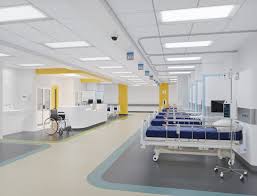How Hospital Interior Design Enhances Patient and Staff Experience

In the evolving world of healthcare, one of the most underestimated yet powerful tools for improving overall outcomes is hospital interior design. Gone are the days when hospitals were synonymous with cold white walls, fluorescent lighting, and sterile environments. Today, designers and healthcare administrators understand that thoughtful and strategic hospital interior decoration not only influences the aesthetic appeal of medical facilities but also significantly impacts the experiences of both patients and staff.
Whether it’s reducing patient anxiety, improving staff efficiency, or streamlining navigation, the design of a hospital has far-reaching implications. This article delves into how interior design plays a transformative role in healthcare environments and how specific areas—like the reception—can set the tone for healing and trust.
The Science of Hospital Interior Design
Healthcare design is no longer just about functionality. It now encompasses psychology, patient behavior, safety, and operational workflow. Hospital interior design integrates evidence-based strategies to promote well-being, efficiency, and emotional comfort.
Key principles include:
-
Biophilic design: Incorporating natural elements like light, plants, and water features to reduce stress.
-
Color psychology: Using calming colors such as soft blues, greens, and earth tones to create a sense of peace.
-
Ergonomic planning: Ensuring spaces are easy to navigate for patients, visitors, and staff.
-
Infection control: Selecting materials and layouts that are hygienic and easy to maintain.
Enhancing Patient Experience Through Interior Design
Patients are the core of any healthcare facility. When they enter a hospital, their emotional state is often anxious or vulnerable. Here’s how thoughtful interior design can make a difference:
1. Aesthetic Comfort
Warm lighting, tactile surfaces, and thoughtfully chosen colors can transform a stark hospital into a soothing environment. A welcoming atmosphere encourages positive emotions, which can support faster recovery and reduced need for medication.
2. Wayfinding and Orientation
Confusing corridors and inconsistent signage are major sources of frustration for patients and visitors. Hospital interior decoration should incorporate clear, intuitive wayfinding systems—using visual cues, color-coded paths, and strategic signage to ease navigation.
3. Privacy and Personal Space
Designing patient rooms with semi-private zones, acoustic insulation, and control over lighting and temperature fosters a sense of autonomy and dignity. These features contribute to a more restful and healing atmosphere.
4. Connection with Nature
Where possible, integrating gardens, skylights, or even wall art featuring natural scenes can dramatically improve the mood of patients. Natural elements are proven to lower blood pressure and stress levels, positively influencing healing.
Improving Staff Performance and Satisfaction
While patients are central, the staff is the backbone of hospital functionality. A well-designed interior contributes to improved morale, lower turnover, and higher efficiency.
1. Operational Efficiency
Optimizing layouts—such as placing nurse stations centrally, minimizing distance between high-use areas, and ensuring adequate storage—can drastically reduce fatigue and increase productivity.
2. Rest and Recovery Spaces
Designing break rooms and lounges where staff can relax, recharge, and find respite is crucial. Comfortable furniture, calming lighting, and a quiet atmosphere can make a difference in handling high-pressure tasks.
3. Safe Workflows
Incorporating clear zoning between clean and contaminated zones, designing for smooth patient transfer, and ensuring good visibility all contribute to safer and smoother staff operations.
Reception Hospital Interior Design: First Impressions Matter
The reception hospital interior design is often a patient’s first interaction with the healthcare space. It shapes their initial impressions and sets the emotional tone for their journey.
1. Welcoming and Non-threatening Environment
Instead of sterile check-in counters and impersonal waiting areas, reception zones should feel warm, approachable, and organized. Soft seating, artwork, natural lighting, and thoughtful layout can reduce stress and encourage calmness.
2. Functionality Meets Aesthetics
While beauty is important, the reception area must be functional. Features like accessible counters, efficient queue systems, and multilingual signage ensure that form complements function.
3. Technology Integration
Modern hospitals are adopting digital kiosks, self-service check-in systems, and integrated lighting and sound systems in reception areas to improve speed and experience.
Hospital Interior Decoration: More Than Just a Pretty Face
Hospital interior decoration extends beyond furniture and wall colors. It reflects the hospital’s brand identity, values, and commitment to care.
Key Decorative Elements:
-
Artwork with calming themes
-
Soft furnishings for comfort
-
Accent lighting to create ambience
-
Green walls and indoor plants to bring nature inside
-
Acoustic panels to reduce noise and promote tranquility
All these elements work in unison to create a more humane and healing atmosphere—important for both short-term visitors and long-term in-patients.
Sustainable Hospital Design: The Future of Healthcare
As environmental concerns grow, hospital interior design must consider sustainability. Using eco-friendly materials, energy-efficient lighting, and recyclable decor elements not only reduce a facility’s carbon footprint but also promote a healthier indoor environment.
Designs that focus on natural ventilation, daylighting, and locally sourced materials contribute to both operational cost savings and environmental responsibility.
Cultural Sensitivity and Inclusivity in Design
Hospitals serve diverse populations. Interior design should accommodate different needs, languages, physical abilities, and cultural expectations. For instance:
-
Designing gender-neutral restrooms
-
Providing prayer or meditation rooms
-
Creating accessible navigation for the differently-abled
-
Displaying multilingual signage and culturally inclusive imagery
Real-World Impact: The Hidecor Approach
Many modern healthcare facilities are working with experienced interior design consultants to realize these benefits. One such firm, Hidecor, has been involved in elevating healthcare spaces with a focus on patient-centric design, staff wellness, and operational flow.
By blending artistic vision with practical application, they demonstrate how intentional design can reimagine the hospital experience for everyone involved.
Conclusion
The influence of hospital interior design goes far beyond mere aesthetics. It’s a multidisciplinary practice that impacts health outcomes, emotional well-being, staff efficiency, and overall patient satisfaction. From the warmth of a well-designed reception area to the calming effects of a thoughtfully decorated patient room, every element contributes to a more humane healthcare experience.







